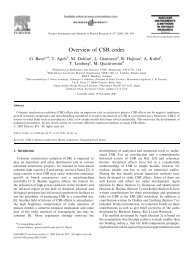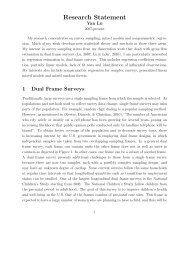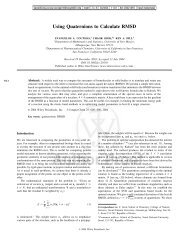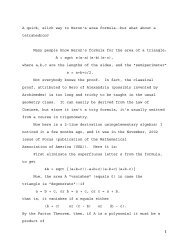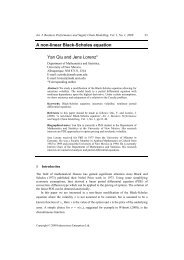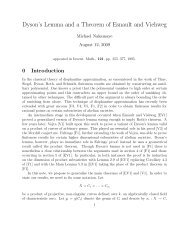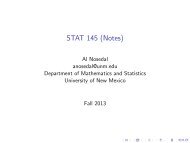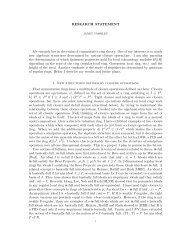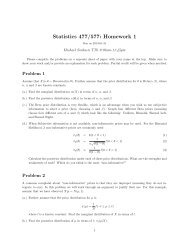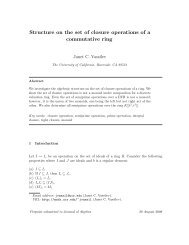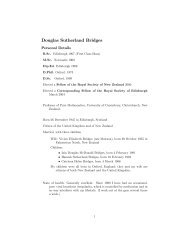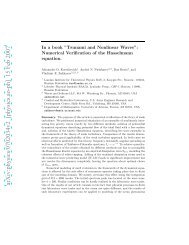OEO Office of Equal Opportunity - Department of Mathematics and ...
OEO Office of Equal Opportunity - Department of Mathematics and ...
OEO Office of Equal Opportunity - Department of Mathematics and ...
Create successful ePaper yourself
Turn your PDF publications into a flip-book with our unique Google optimized e-Paper software.
HISTORY 217<br />
220. Studies in History. (1-3, no limit) ∆<br />
Will vary from instructor to instructor but will <strong>of</strong>fer a review <strong>of</strong><br />
particular historical issues designed for the nonspecialist. For<br />
content <strong>of</strong> particular courses, see Schedule <strong>of</strong> Classes <strong>and</strong><br />
contact <strong>Department</strong>. {Fall, Spring}<br />
251. Traditional Eastern Civilizations. (3) Porter, Risso<br />
The origin <strong>and</strong> development <strong>of</strong> the traditional societies <strong>and</strong><br />
cultures <strong>of</strong> India, Southeast Asia, China, Japan <strong>and</strong> the<br />
Middle East.<br />
252. Modern Eastern Civilizations. (3) Porter, Risso<br />
The emergence <strong>of</strong> modern Asia from the impact <strong>of</strong> western<br />
colonialism <strong>and</strong> imperialism to nationalism, modernization<br />
<strong>and</strong> revolution.<br />
304./504. The High Middle Ages, 1050 to 1400. (3)<br />
Graham, Rubenstein<br />
The maturing <strong>of</strong> medieval civilization: Gregorian reform,<br />
the Crusades, the rise <strong>of</strong> the university <strong>and</strong> the Gothic<br />
cathedral.<br />
305./505. Renaissance Era, 1300 to 1520. (3)<br />
Rubenstein<br />
The decline <strong>of</strong> medieval civilization <strong>and</strong> the transition to a new<br />
phase <strong>of</strong> European history.<br />
314./514. Old Russia from the Ninth to the Seventeenth<br />
Century. (3) Robbins<br />
Survey <strong>of</strong> the Kievan, Mongol <strong>and</strong> Muscovite periods.<br />
Emphasis on political <strong>and</strong> social developments.<br />
260. History <strong>of</strong> New Mexico. (3) Ball, Reyes, Truett<br />
Introduction to New Mexico history from earliest human<br />
settlement to the present day.<br />
281. History <strong>of</strong> Early Latin America. (3) Gauderman,<br />
Bieber<br />
An introduction to indigenous, African <strong>and</strong> Iberian backgrounds.<br />
Examines colonial societies through social,<br />
economic <strong>and</strong> political institutions with attention to the contributions<br />
<strong>of</strong> Indians, Africans <strong>and</strong> Europeans to the creation <strong>of</strong><br />
Latin America’s diverse societies.<br />
282. Modern Latin American History. (3) Bieber, Hall,<br />
Hutchison<br />
Surveys the nations <strong>of</strong> Latin America from their independence<br />
until the present. Emphasizes the process <strong>of</strong> nation-building,<br />
governance, socioeconomic integration <strong>and</strong> coping with<br />
modernization. Special attention given to great leaders <strong>of</strong><br />
Latin America. {Spring}<br />
284. African-American History. (3)<br />
(Also <strong>of</strong>fered as AFAM 284.) The course examines major<br />
events <strong>and</strong> personalities that shaped the history <strong>of</strong> African<br />
Americans in the United States.<br />
285. African-American History II.<br />
(Also <strong>of</strong>fered as AFAM 285.) This course will explore each<br />
<strong>of</strong> the major historical events, Black leaders <strong>of</strong> those times<br />
<strong>and</strong> their influence on the social <strong>and</strong> political advancement <strong>of</strong><br />
Afro-American from the Civil War to the present.<br />
335. Russian Culture <strong>and</strong> History through Film. (3)<br />
(Also <strong>of</strong>fered as RUSS 339 <strong>and</strong> MA 339.) In this course we<br />
study films <strong>and</strong> read secondary sources from the Soviet <strong>and</strong><br />
post-Soviet eras (with English subtitles) <strong>and</strong> examine how<br />
they comment on current Russian social <strong>and</strong> cultural issues.<br />
Taught in English.<br />
II. Foundations <strong>of</strong> European<br />
Civilization<br />
300./500. Studies in History. (1-3, no limit) ∆<br />
Will vary from instructor to instructor, but will be an in-depth<br />
analysis <strong>of</strong> specific historical problems. For course content,<br />
consult Schedule <strong>of</strong> Classes.<br />
301./501. Greece. (3)<br />
A political <strong>and</strong> social survey <strong>of</strong> the Greek people from the<br />
Mycenaean world through the long autumn <strong>of</strong> Hellenistic age<br />
<strong>and</strong> the arrival <strong>of</strong> the Romans.<br />
302./502. Rome. (3)<br />
A political <strong>and</strong> social survey <strong>of</strong> the Roman people from their<br />
origins on the Tiber through the glories <strong>of</strong> Empire to the final<br />
collapse <strong>of</strong> classical society in the 6th century.<br />
303./503. Early Middle Ages, 300 to 1050. (3) Graham,<br />
Rubenstein<br />
The emergence <strong>of</strong> medieval European civilization from the<br />
reign <strong>of</strong> Constantine to the beginnings <strong>of</strong> the papal monarchy.<br />
320./520. History <strong>of</strong> Women from Ancient Times to the<br />
Enlightenment. (3) Slaughter<br />
(Also <strong>of</strong>fered as WMST 315.) Study <strong>of</strong> sex roles in primitive<br />
societies, classical views <strong>of</strong> women, the Judeo-Christian<br />
treatment <strong>of</strong> women, medieval social roles <strong>and</strong> the changes<br />
that came with the Renaissance <strong>and</strong> Reformation. Attention<br />
will be paid to the role <strong>of</strong> women in the family <strong>and</strong> to their<br />
economic function as well as to the less common activities <strong>of</strong><br />
saint, witch <strong>and</strong> revolutionary.<br />
401./601. Anglo-Saxon Engl<strong>and</strong>, 450–1066. (3) Graham<br />
This course will <strong>of</strong>fer an overview <strong>of</strong> the history <strong>and</strong> culture <strong>of</strong><br />
Engl<strong>and</strong> from the arrival <strong>of</strong> the Angles <strong>and</strong> Saxons in the middle<br />
<strong>of</strong> the fifth century until the Battle <strong>of</strong> Hastings <strong>of</strong> 1066.<br />
402./602. The Crusades. (3) Rubenstein<br />
This course will examine the phenomenon <strong>of</strong> the Crusades in<br />
the Middle Ages, examining the three (arguably more) distinct<br />
cultures involved <strong>and</strong> addressing issues relevant to social,<br />
political, intellectual <strong>and</strong> military history.<br />
III. Early Modern Europe<br />
300./500. Studies in History. (1-3, no limit) ∆<br />
Will vary from instructor to instructor, but will be an in-depth<br />
analysis <strong>of</strong> specific historical problems. For course content,<br />
consult Schedule <strong>of</strong> Classes.<br />
306./506. Reformation Era, 1500–1600. (3) Steen<br />
(Also <strong>of</strong>fered as RELG 306.) Religious revolution <strong>and</strong> concurrent<br />
developments in European politics, society <strong>and</strong> culture.<br />
307./507. Europe in the Seventeenth Century. (3) Steen<br />
Survey <strong>of</strong> political, cultural, social <strong>and</strong> economic trends<br />
in Europe during Thirty Years War <strong>and</strong> reign <strong>of</strong> Louis XIV.<br />
Special emphasis on developments in Engl<strong>and</strong>, France <strong>and</strong><br />
Hapsburg dominions.<br />
308./508. Europe in the Eighteenth Century, 1700–1788.<br />
(3) Steen<br />
Survey <strong>of</strong> the political, cultural, social <strong>and</strong> economic situation<br />
in Europe at height <strong>of</strong> Old Regime. Emphasis will be<br />
on intellectual <strong>and</strong> social developments that culminated in<br />
French Revolution.<br />
309./509. The French Revolution <strong>and</strong> Napoleon, 1789–<br />
1815. (3) Steen<br />
Survey <strong>of</strong> the course <strong>of</strong> the revolution <strong>and</strong> its impact on<br />
France <strong>and</strong> on European social, political, economic <strong>and</strong><br />
military life.<br />
315./515. Romanov Russia to 1855. (3) Robbins<br />
From the Time <strong>of</strong> Troubles to the death <strong>of</strong> Nicholas I. Stresses<br />
the development <strong>of</strong> political institutions <strong>and</strong> the origins <strong>of</strong> the<br />
revolutionary movement.<br />
318./518. Spain <strong>and</strong> Portugal to 1700. (3) Sanabria<br />
The consolidation <strong>and</strong> expansion <strong>of</strong> the Christian empires <strong>of</strong><br />
Aragón, Castile <strong>and</strong> Portugal across Iberia <strong>and</strong> the Atlantic,<br />
from Muslim times to the War <strong>of</strong> Spanish Succession.<br />
ARTS AND<br />
SCIENCES<br />
UNM CATALOG 2006–2007 Symbols, page 611.



